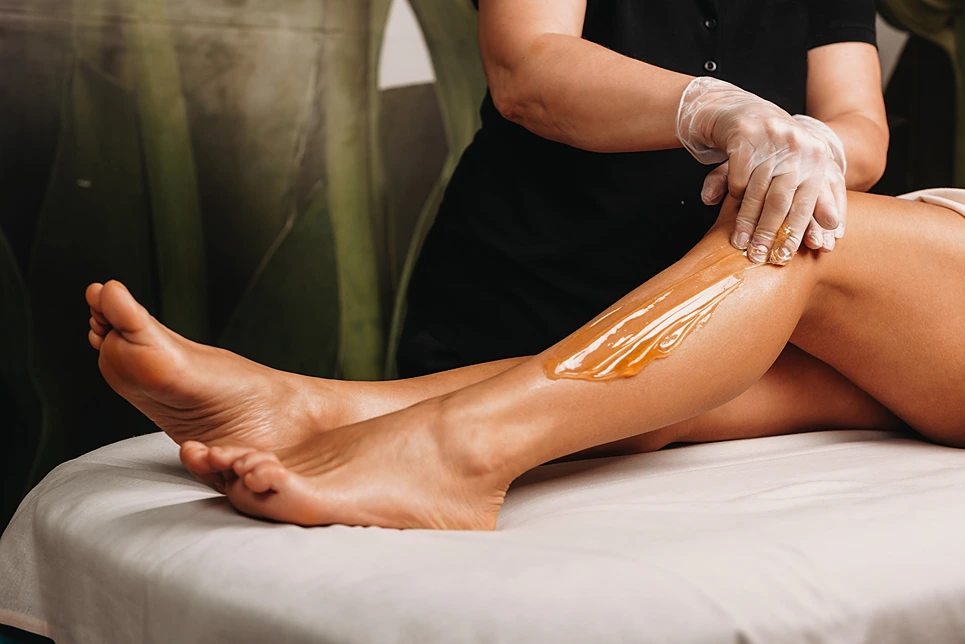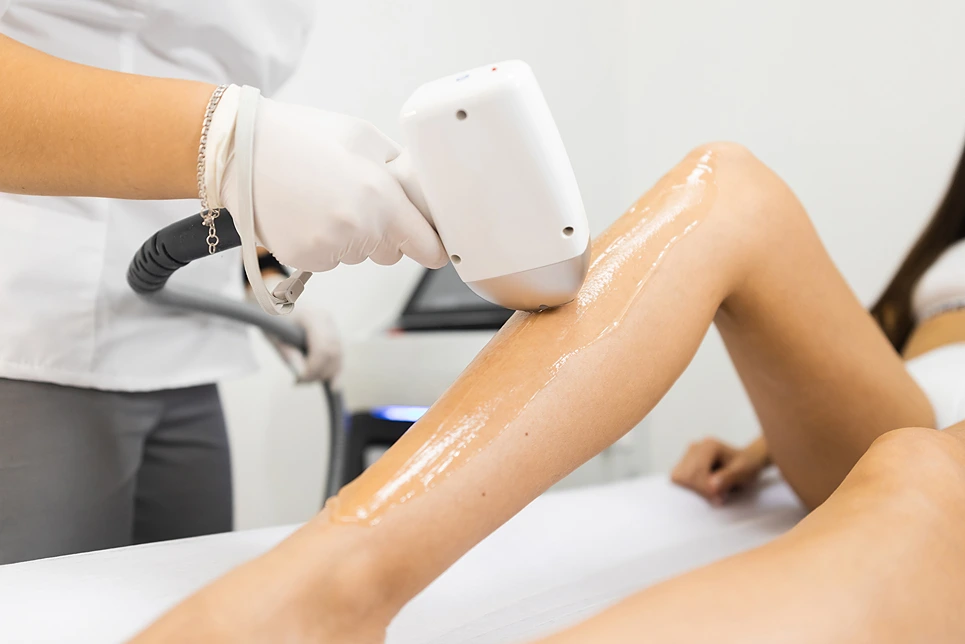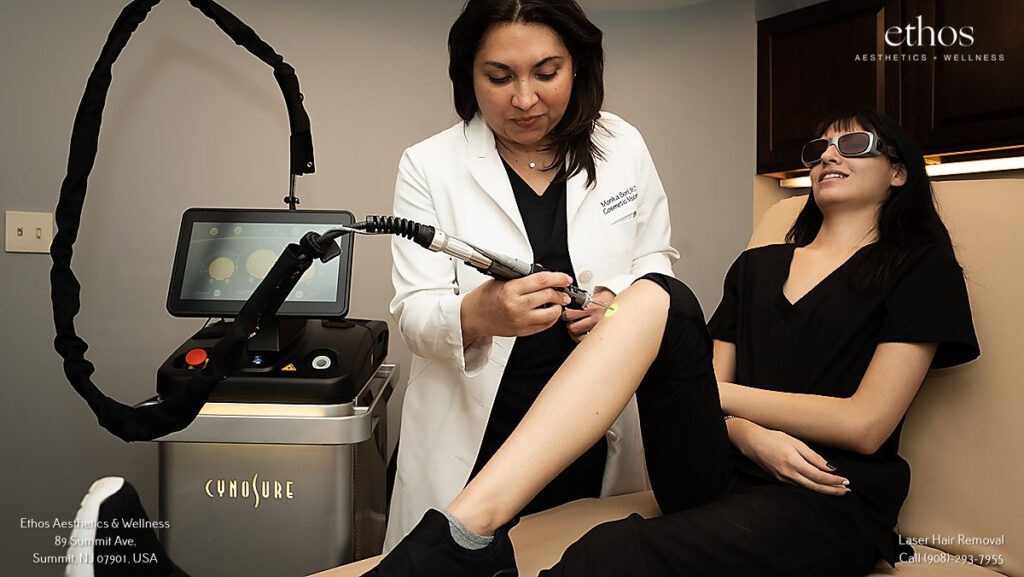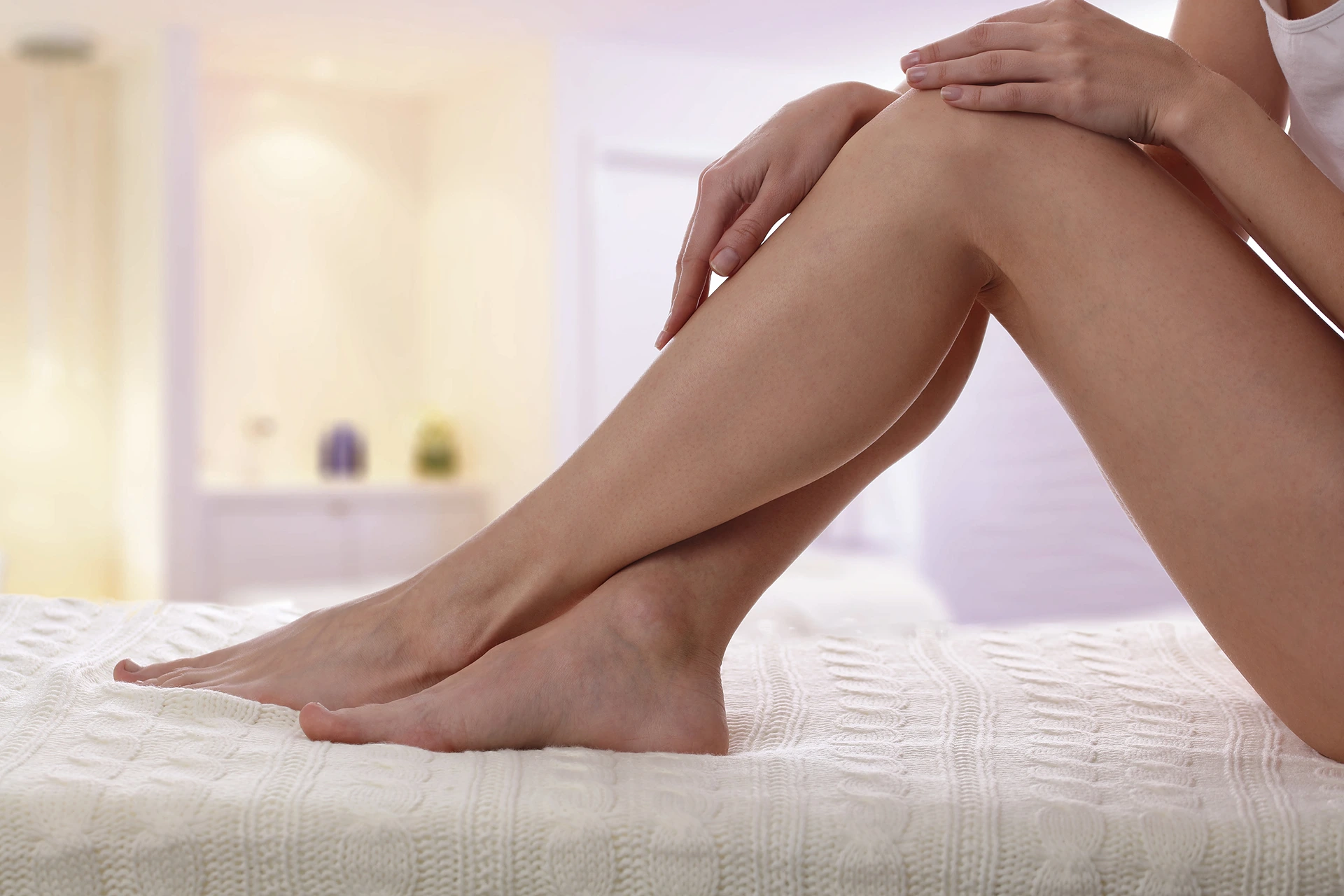Bare Necessities: Discover the Best Route to Silky Skin
Smooth, hair-free skin is a desirable aesthetic goal for many. However, achieving this often requires regular hair removal.
Two of the most popular options are waxing and laser hair removal. But which method is better for your needs?
To help decide between waxing and laser, we consulted Dr. Hardik Soni, an expert from Ethos Aesthetics + Wellness. Read on as we compare these two methods across various factors to determine the ideal choice for you.
What Is Waxing?

Waxing involves applying a thick, sticky wax to the areas of unwanted hair growth. The wax adheres to the hair strands and is then removed quickly, pulling the hair out from the root.
There are two main types of wax:
- Soft wax – Also called strip wax. Applied in a thick layer and removed with cloth or paper strips. Best for large areas.
- Hard wax – Also called bead wax. Applied in a thinner layer and allowed to harden before being removed by hand. Better for sensitive areas.
Waxing can be performed on most body areas, including the face, arms, legs, underarms, and bikini line. The coarseness and density of hair growth will determine the effectiveness.
What Is Laser Hair Removal?
Laser hair removal uses concentrated beams of light to selectively damage the hair follicles. The specific wavelength of light targets the pigment in the hair shaft, penetrating through the skin and disabling the follicle’s ability to regrow.
There are three main laser types:
- Alexandrite laser – Best for light skin with dark hair. Wavelength of 755 nm.
- Nd:YAG laser – Ideal for darker skin tones. 1064 nm wavelength.
- Diode laser – Effective for light or dark skin. Wavelength of 800 – 810 nm.
Laser works best for coarse, dense hair growth on all body parts. It is better suited for large areas rather than small, localized hair.
How Each Method Works
Waxing and laser hair removal employ very different mechanisms for removing hair:
Waxing uses mechanical action to pull out the entire hair strand from the pore. The wax adheres firmly to the hair fibers when applied against the direction of growth. The strip is then removed swiftly in the direction of hair growth, extracting the encased hair by the root.
Dr. Soni explains that this traumatic extraction can damage the papilla cells at the base of the follicles, delaying hair regrowth. However, the papilla remains intact, allowing hair to eventually grow back.
Laser hair removal uses selective photothermolysis to target the hair follicles. The laser device emits a beam of light that passes through the skin and is absorbed by the melanin pigment in the hair shaft. This creates heat that damages the hair follicle, disabling its ability to regrow.
According to Dr. Soni, laser precisely destroys the hair bulb and papilla cells, providing longer-lasting hair removal, although several treatments are needed for complete results.
Effectiveness and Longevity

When comparing the effectiveness and longevity of waxing vs laser hair removal, laser emerges as the clear winner:
Waxing removes hair effectively from the root when performed regularly, every 3-6 weeks. However, it only damages the hair follicle temporarily. With waxing, hair regrowth occurs within 2-8 weeks as the papilla remains intact.
Dr. Soni confirms that while waxing can reduce hair density over time if maintained consistently, the results cannot match the longevity of laser hair removal.
In contrast, laser precisely targets the hair follicle’s regrowth capacity, not just the visible hair above the skin. Most patients require 4-6 sessions spaced 4-6 weeks apart for optimal results.
This achieves 60-90% permanent hair reduction, allowing hair to be kept away for several months or even years with occasional touch-up sessions.
For maximum hair removal, laser prevails over waxing with its long-lasting destruction of hair follicles and papilla cells, states Ethos Aesthetics + Wellness.
Side Effects and Risks
Both waxing and laser come with possible side effects and risks:
Waxing can cause redness, swelling, irritation, and ingrown hairs on sensitive skin. Hard wax can rip skin if not removed properly. There are also risks of burns and scarring if inexperienced technicians apply improper waxing techniques.
Dr. Soni cautions that waxing should be avoided on irritated skin, varicose veins, moles, and skin disorders like psoriasis or eczema where the risks are higher. Ethos Aesthetics + Wellness provides in-depth skin assessments prior to waxing to minimize adverse effects.
With laser hair removal, patients can experience redness, swelling, skin irritation, and changes in pigmentation, especially on darker skin tones. Blistering and scarring are also possible risks if laser parameters are not customized to the individual’s needs by an experienced professional.
Dr. Soni recommends minimizing sun exposure before and after laser sessions, avoiding any tanning or chemical peels around the time of treatment.
Ethos Aesthetics + Wellness calibrates laser settings carefully based on clients’ medical profile and skin/hair type. They also provide caring aftercare to aid healing.
Cost Comparison
The costs of waxing vs laser differ considerably:
Waxing prices range from $25-$100 per session depending on the body part:
- Lip or chin wax: $10-$25
- Underarms: $20-$40
- Half arms: $20-$45
- Bikini: $25-$60
- Full legs: $40-$100
With regular maintenance every 3-6 weeks, the annual costs can add up significantly, advises Dr. Soni. Hence, waxing works better for small areas or temporary removal. For larger areas, the expenses pile up over time.
Laser hair removal has higher upfront costs but lower long-term costs:
- Upper lip: $150-$250 per session
- Underarms: $200-$350
- Bikini: $300-$500
- Back or chest: $600-$1500
- Full legs: $600-$1500
Although the per session cost seems high, after the initial 4-6 sessions, only annual or bi-annual touch-ups are required for maintenance.
This means over time, laser becomes more affordable and cost-effective than recurrent waxing, explains Ethos Aesthetics + Wellness. It’s ideal for those seeking permanent hair reduction in larger body areas.
Who Are the Ideal Candidates for Each Treatment?

The suitability of waxing vs laser depends on these factors:
Waxing works best for people with coarse, dark hair about 1⁄4 inch long. Those with sensitive skin prone to rashes or ingrown hair may not tolerate waxing well. It’s ideal for smaller areas and temporary removal needs.
Dr. Soni recommends waxing for:
- Removing fine, vellus hairs on the face, arms or legs
- Occasional touch-ups between laser sessions
- Small areas like the lip, chin, or toes
Laser is ideal for light skin with dark coarse hair that responds poorly to waxing. People seeking permanent reduction in larger areas benefit most from laser.
According to Dr. Soni, the best laser candidates have:
- Coarse, dark terminal hairs
- Light to medium skin tones
- Hormonally-driven hair growth or genetic disposition
- Large areas for treatment like the legs, arms, back, or chest
Those prone to keloid scarring or with very dark skin tones should opt for laser with caution and proper pre-treatment consultation.
Maintenance and Aftercare
To maintain smooth skin, waxing and laser both require some degree of aftercare:
For waxing, exfoliating regularly is important to prevent ingrown hairs. Dr. Soni advises gently scrubbing with a loofah sponge or dry brushing weekly to remove dead skin cells that can trap new hair beneath.
Moisturizing is also recommended to soothe inflammation and keep skin supple between waxing sessions. Avoid sun exposure for 24-48 hours pre and post-waxing.
With laser hair removal, patients must protect treated skin from sunlight with sunscreen for 6 weeks and avoid tanning. Tweezing, waxing and chemical/mechanical exfoliation should also be avoided during treatment and in-between sessions.
Dr. Soni prescribes anti-inflammatory creams, antibiotic ointments, or silicone gels for soothing and healing. This prevents complications like blistering or burning. Regular moisturization is also encouraged to keep skin calm and hydrated.
Side-by-Side Comparison: Waxing vs. Laser Hair Removal
| Factor | Waxing | Laser Hair Removal |
| Cost per Session | Typically ranges from $25 to $100, varying by body area and location. | Generally between $150 to $1500, heavily dependent on treatment area size and geographic location. |
| Sessions Required | Requires maintenance every 3-6 weeks for ongoing hair removal. | Initial series of 4-6 sessions followed by potential annual touch-ups for maintenance. |
| Effectiveness | Temporarily removes hair at the root for smooth skin. | Targets and permanently reduces hair growth by damaging hair follicles. |
| Ideal Candidates | Best for individuals with any hair and skin type, particularly effective for those seeking temporary removal on small areas. | Most effective for individuals with light skin and dark hair due to the contrast needed for the laser targeting, though newer technologies accommodate a wider range of skin and hair types. |
| Areas Treated | Effective for smaller, sensitive areas such as the face, underarms, and bikini line. | Ideal for larger body areas including legs, back, chest, and arms, as well as smaller areas. |
| Side Effects | Commonly causes redness, irritation, and potential for ingrown hairs. | May include redness, swelling, changes in pigmentation, and rare instances of blistering. Specific risks depend on skin type and laser used. |
| Aftercare | Recommended to exfoliate regularly to prevent ingrown hairs, moisturize the skin, and avoid direct sunlight to treated areas. | Post-treatment care may include applying antibiotic creams or silicone gels for healing, along with strict sun protection (SPF). |
| Hair Regrowth Timeline | Hair typically regrows within 2 to 8 weeks, varying by individual growth cycles. | Significantly reduced hair growth for months or years; some may experience permanent hair loss in treated areas. |
| Pain Level | Described as moderately painful, with the sensation of a quick, sharp pull. | Often compared to a rubber band snapping against the skin; cooling methods and numbing creams can reduce discomfort. |
| Professional Training Required | Requires proficiency in wax application and removal techniques for optimal results and safety. | Must be performed by or under the supervision of a physician with specialized training in laser equipment and skin care. |
| Appointment Duration | Quick sessions lasting 15 to 30 minutes, depending on the area being waxed. | Longer sessions ranging from 60 to 90 minutes, based on the size of the treatment area and the type of laser used. |
| Convenience | Minimal preparation needed, though hair must be a certain length for effective removal. | Requires specific pretreatment measures, such as avoiding sun exposure and not waxing or plucking hair prior to sessions. |
The Best of Both Worlds: Navigating Hair Removal Choices

Both waxing and laser hair removal have their merits and downsides.
Wax On, Wax Off: The Quick Fix
Waxing stands out for its affordability and convenience, offering a straightforward solution for managing hair growth on smaller areas. It’s a go-to for those needing a quick touch-up with immediate results.
Laser Precision: A Long-Term Investment
Laser hair removal shines when it comes to reducing hair growth over large areas. With technology that targets hair follicles for a lasting effect, it promises a smoother tomorrow for those looking for a more permanent solution.
As Dr. Soni suggests, consider your hair characteristics, skin type, pain tolerance, time commitments, and budget when deciding between these two popular hair removal options.
For the best results, consult a trained professional who can assess your individual needs and recommend the optimal treatment plan.
With professional guidance and care from providers like Ethos Aesthetics + Wellness, you can achieve smooth, stubble-free skin using either waxing or laser hair removal tailored specifically for you.
Begin Your Journey to Perfection: Consult the Pros for Flawless Results
For more insights on effectively removing unwanted body and facial hair, book a consultation with Dr. Hardik Soni at Ethos Aesthetics + Wellness. Get a customized treatment plan and professional care for optimal waxing or laser hair removal results. Call or book online today.







